STL之优先级队列(堆)的模拟实现与仿函数
文章目录
优先级队列的概念
优先队列是一种容器适配器,根据严格的弱排序标准,它的第一个元素总是它所包含的元素中最大的。
本质就是一个堆!
此上下文类似于堆,在堆中可以随时插入元素,并且只能检索最大堆元素(优先队列中位于顶部的元素)。
. 优先队列被实现为容器适配器,容器适配器即将特定容器类封装作为其底层容器类,queue提供一组特定的成员函数来访问其元素。元素从特定容器的“尾部”弹出,其称为优先队列的顶部。
底层容器可以是任何标准容器类模板,也可以是其他特定设计的容器类。容器应该可以通过随机访问迭代器访问,并支持以下操作:
- empty():检测容器是否为空
- size():返回容器中有效元素个数
- front():返回容器中第一个元素的引用
- push_back():在容器尾部插入元素
- pop_back():删除容器尾部元素
标准容器类vector和deque满足这些需求。默认情况下,如果没有为特定的priority_queue类实例化指定容器类,则使用vector。
需要支持随机访问迭代器,以便始终在内部保持堆结构。容器适配器通过在需要时自动调用算法函数make_heap、push_heap和pop_heap来自动完成此操作
list不支持随机访问!所以不能当做其标准容器类!
priority_queue的接口介绍
pop:删除堆顶的数据
top:取出堆顶的数据
push:向堆插入数据
size:返回堆里面的元素个数
empty:判断堆是否为空
swap:交换两个堆
优先级队列的构造函数
可以使用迭代器进行初始化!
但是这个迭代器是一个随机迭代器!
//简单使用 #pragma once #include <queue> #include<iostream> #include <functional>//less和greater的头文件 using namespace std; int main() { //大堆 priority_queue <int> pq; pq.push(3); pq.push(1); pq.push(2); pq.push(5); while (!pq.empty()) { cout << pq.top() << ' '; pq.pop(); } cout << endl; //小堆 priority_queue <int,vector<int>,greater<int>> pq1; pq1.push(3); pq1.push(1); pq1.push(2); pq1.push(5); while (!pq1.empty()) { cout << pq1.top() << ' '; pq1.pop(); } cout << endl; return 0; }
priority_queue模拟实现
容器适配器是不需要迭代器的!如果有了迭代器是不能保证最大/最小的先出!
类成员
namespace MySTL { template<class T,class Container = std::vector<T>> class priority_queue { private: Container _con; }; }
构造函数
namespace MySTL
{
template<class T,class Container = std::vector<T>>
class priority_queue
{
public:
priority_queue()
{}
template<class InputIterator>
priority_queue(InputIterator first,InputIterator last)
:_con(first,last)//直接调用vector的构造
{
//此时还不是堆!
//向下调整建堆!
for (int i = (_con.size() - 2) / 2; i >= 0; i++)
{
adjust_down(i);
}
}
private:
Container _con;
};
}
向下调整算法——正常实现
namespace MySTL
{
template<class T,class Container = std::vector<T>>
class priority_queue
{
private:
void adjust_down(size_t parent)
{
size_t child = parent*2 +1;
while (child < _con.size())
{
if (child + 1 < _con.size() && _con[child] < _con[child + 1])
child++;
if (_con[parent] < _con[child])//建大堆
{
std::swap(_con[parent], _con[child]);
parent = child;
child = parent * 2 + 1;
}
else
{
break;//没有更大的了,退出
}
}
}
private:
Container _con;
};
}
向下调整算法的核心将父节点和自己的两个子节点对比,找到其中一个最大(大堆)的或者最小(小堆)的子节点!然后比较,如果是建大堆,若父节点比子节点还要小,那么交换!如果是建小堆,若父节点比子节点还要大,那么交换!,直到父节点比最大子节点还要大(大堆),或者是比最小的子节点还要小(小堆)则跳出循环!或者直接调整到最后一个节点!
push
namespace MySTL { template<class T,class Container = std::vector<T>> class priority_queue { public: void push(const T& value) { //插入后要保持堆的结构! //要进行向上调整! _con.push_back(value); adjust_up(_con.size()-1); } private: Container _con; }; }
向上调整——正常实现
namespace MySTL
{
template<class T,class Container = std::vector<T>>
class priority_queue
{
private:
void adjust_up(size_t child)
{
size_t parent = (child - 1) / 2;
while (child > 0)
{
if (_con[child] > _con[parent])//建大堆!
{
std::swap(_con[child], _con[parent]);
child = parent;
parent = (child - 1) / 2;
}
else
{
break;
}
}
}
private:
Container _con;
};
}
//这里如果使用parent>0,那么因为子节点还在下一个位置,则无法调整根节点
//如果是parent>=0 因为parent =(0-1)/2 仍然为0,则就会出现死循环!
向上调整,就是将现在子节点和父节点对比一下!然后如果是建大堆,若子节点大于父节点那么进行交换!
如果是建小堆,若子节点小于父节点,那么也交换!
结束条件:直到根节点是孩子,或者建大堆的时候,孩子比父亲小(建小堆的时候,孩子比父亲大!)
向上调整算最好使用孩子作为循环借宿的条件!
pop
namespace MySTL { template<class T,class Container = std::vector<T>> class priority_queue { public: void pop() { //交换 std::swap(_con[0], _con[_con.size()-1]); //删除最后一个元素 _con.pop_back(); //向下调整算法! adjust_down(0); } private: void adjust_down(size_t parent) { size_t child = parent*2 +1; while (child < _con.size()) { if (child + 1 < _con.size() && _con[child] < _con[child + 1]) child++; if (_con[parent] < _con[child])//建大堆 { std::swap(_con[parent], _con[child]); parent = child; child = parent * 2 + 1; } else { break;//没有更大的了,退出 } } } private: Container _con; }; }
int main() { MySTL::priority_queue <int> pq; pq.push(3); pq.push(1); pq.push(2); pq.push(5); while (!pq.empty()) { cout << pq.top() << ' '; pq.pop(); } cout << endl; return 0; }
仿函数/函数对象
仿函数的概念
首先仿函数究竟是什么呢?——是一个类!仿函数的类型对象我们叫做函数对象!
template<class T> struct less { bool operator()(const T& x,const T& y) { return x < y; } }; template<class T> struct greater { bool operator()(const T& x,const T& y) { return x > y; } };仿函数的要求是要重载(),()这也是一个运算符!例如像是我们去调用pq1.pop()的函数,后面的()就是一个函数调用符!
int main() { less<int> lessFunc; lessFunc(0, 1); return 0; }如果不看上面的类的定义,单看后面的lessFunc(0,1),这就是一个函数调用!函数名是lessFunc——但是现在实际上是一个类!这就是为什么这个叫做仿函数!这个对象叫做函数对象!指的就是这个对象能像函数一样被使用!
但是这个其实也是一个函数调用
lessFunc(0, 1);//将这个转换为一个运算符重载! lessFunc.operator()(0, 1);//等价于上面上面的!
仿函数的作用
那么仿函数究竟有什么作用呢?看起来和一般的函数区别?而且还多了一个封装!看起来更加的麻烦了!
我们可以举一个例子来看
//这是C语言的一个冒泡排序! void BubbleSort(int* a, int size,bool(*cmp)(int,int)) { for (int i = 0; i < size; i++) { int exchange = 0; for(int j = 1.;j<size-i;j++) { if (cmp(a[j-1],a[j])) { std::swap(a[j - 1], a[j]); exchange = 1; } } if (!exchange) { break; } } }我们可以 看到在C语言中,如果我们想要解决升序降序的问题,我们就要传一个函数指针过来!——如果不用函数指针那么我们就只能重新写一个函数了!
那么在C++中的类里面我们是否也可以传一个函数指针呢?可以!但是这样子不好看!C++的设计都是在尽量的不去使用指针!
所以仿函数这时候就派上用场了!
template <class T,class Compare> void BubbleSort(T* a, int size,Compare com)//因为Compare其实是一个类所以要显示实例化!而不是模板函数一样是推演实例化!所以要多加一个参数 { for (int i = 0; i < size; i++) { int exchange = 0; for(int j = 1.;j<size-i;j++) { //if (a[j] < a[j - 1]) if (com(a[j], a[j - 1])) { std::swap(a[j - 1], a[j]); exchange = 1; } } if (!exchange) { break; } } } int main() { less<int> lessFunc; int a[] = { 1,5,7,8,94,24,5,3,56,7 ,90 }; BubbleSort(a, sizeof(a) / sizeof(a[0]), lessFunc);//升序排序 //BubbleSort(a, sizeof(a) / sizeof(a[0]), less<int>()); //怎么写也是可以的!因为是一个匿名对象!如果这个函数对象是要使用一次的话!可以直接使用!匿名对象! for (auto& e : a) { std::cout << e << " "; } std::cout << std::endl; greater<int> greaterFunc; int b[] = { 1,5,7,8,94,24,5,3,56,7 ,90 }; BubbleSort(b, sizeof(b) / sizeof(b[0]), greaterFunc);//降序排序! //BubbleSort(b, sizeof(b) / sizeof(b[0]), greater<int>()); for (auto& e : b) { std::cout << e << " "; } return 0; }
less和greater就是我们刚刚写的仿函数!
从我们实现代码的角度来说,这是一个泛型,是一个逻辑泛型——即com是一个逻辑!如果需要升序就传一个lessFunc,如果要降序就传一个greaterFunc
类型泛型就是不限类型!逻辑泛型就是不限逻辑!
仿函数一般都是传值,因为仿函数的拷贝代价很小!仿函数里面没有成员变量!所以只有一个字节作为标记位!
但是如果想要传引用也行!
void BubbleSort(T* a, int size,const Compare& com)//也是可以传引用的!但是要加上const否则就无法接收匿名对象!因为匿名对象具有常性 { for (int i = 0; i < size; i++) { int exchange = 0; for(int j = 1.;j<size-i;j++) { //if (a[j] < a[j - 1]) if (com(a[j], a[j - 1]))//因为是const对象调用所以仿函数内部都要加上const { std::swap(a[j - 1], a[j]); exchange = 1; } } if (!exchange) { break; } } }template<class T> struct less { bool operator()(const T& x,const T& y)const//加上const让const对象能够调用! { return x < y; } }; template<class T> struct greater { bool operator()(const T& x,const T& y)const { return x > y; } };我们也可以看到传引用其实很麻烦!所以没有什么必要!
使用仿函数来实现优先级队列的逻辑判断
我们上面的优先级队列要么只能是大堆!要么只能是小堆!不够泛用!原因就是因为我们的逻辑是写死的!但是学会了仿函数之后!我们也可以实现逻辑泛型了!
新增模板参数
template<class T, class Container = std::vector<T>,class Compare = less<T>> class priority_queue { public: // functions private: Container _con; }; }加上第三个模板参数仿函数!
使用仿函数实现泛型的向下调整算法与向上调整算法
namespace MySTL { template<class T> struct less { bool operator()(const T& x, const T& y) { return x < y; } }; template<class T> struct greater { bool operator()(const T& x, const T& y) { return x > y; } }; template<class T, class Container = std::vector<T>,class Compare = less<T>> class priority_queue { public: //functions private: void adjust_up(size_t child) { size_t parent = (child - 1) / 2; Compare com; while (child > 0) { //if (_con[child] > _con[parent])//建大堆! //if (_con[parent] < _con[child])//建大堆! if(com(_con[parent], _con[child]))//我们要与库保持一致要小于实现大堆!那么就要parent在前,就是与上面的逻辑一样 { std::swap(_con[child], _con[parent]); child = parent; parent = (child - 1) / 2; } else { break; } } } void adjust_down(size_t parent) { size_t child = parent*2 +1; Compare com; while (child < _con.size()) { //if (child + 1 < _con.size() && _con[child] < _con[child + 1])) if (child + 1 < _con.size() && com(_con[child], _con[child + 1])))//我们要与库保持一致要小于实现大堆!那么就要child在前 child++; //if (_con[parent] < _con[child])//建大堆 if(com(_con[parent], _con[child])) { std::swap(_con[parent], _con[child]); parent = child; child = parent * 2 + 1; } else { break;//没有更大的了,退出 } } } private: Container _con; }; }测试用例
int main() { //大堆 MySTL::priority_queue <int> pq; pq.push(3); pq.push(1); pq.push(2); pq.push(5); while (!pq.empty()) { cout << pq.top() << ' '; pq.pop(); } cout << endl; //小堆 MySTL::priority_queue <int, vector<int>, greater<int>> pq1; pq1.push(3); pq1.push(1); pq1.push(2); pq1.push(5); while (!pq1.empty()) { cout << pq1.top() << ' '; pq1.pop(); } cout << endl; return 0; }
优先级队列模拟——最终版代码
namespace MySTL
{
template<class T>
struct less
{
bool operator()(const T& x, const T& y)
{
return x < y;
}
};
template<class T>
struct greater
{
bool operator()(const T& x, const T& y)
{
return x > y;
}
};
template<class T, class Container = std::vector<T>,class Compare = less<T>>
class priority_queue
{
public:
priority_queue()//无参构造
{}
template<class InputIterator>
priority_queue(InputIterator first, InputIterator last)
:_con(first, last)//直接调用vector的构造
{
//此时还不是堆!
//向下调整建堆!
for (int i = (_con.size() - 2) / 2; i >= 0; i++)
{
adjust_down(i);
}
}
void push(const T& value)
{
_con.push_back(value);
adjust_up(_con.size()-1);
}
void pop()
{
//交换
std::swap(_con[0], _con[_con.size()-1]);
//删除最后一个元素
_con.pop_back();
//向下调整算法!
adjust_down(0);
}
const T& top() const
{
return _con[0];
}
bool empty() const
{
return _con.empty();
}
size_t size()const
{
return _con.size();
}
private:
void adjust_up(size_t child)
{
size_t parent = (child - 1) / 2;
Compare com;
while (child > 0)
{
//if (_con[child] > _con[parent])//建大堆!
//if (_con[parent] < _con[child])//建大堆!
if(com(_con[parent], _con[child]))//我们要与库保持一致要小于实现大堆!那么就要parent在前
{
std::swap(_con[child], _con[parent]);
child = parent;
parent = (child - 1) / 2;
}
else
{
break;
}
}
}
void adjust_down(size_t parent)
{
size_t child = parent*2 +1;
Compare com;
while (child < _con.size())
{
//if (child + 1 < _con.size() && _con[child] < _con[child + 1])
if (child + 1 < _con.size() && com(_con[child], _con[child + 1]))//我们要与库保持一致要小于实现大堆!那么就要child在前
child++;
//if (_con[parent] < _con[child])//建大堆
if(com(_con[parent], _con[child]))
{
std::swap(_con[parent], _con[child]);
parent = child;
child = parent * 2 + 1;
}
else
{
break;//没有更大的了,退出
}
}
}
private:
Container _con;
};
}
仿函数的应用
要知道我们优先级队列的类型可以不只是库里面的类型!还可以是自定义类型!
class Date { public: Date(int year = 1900, int month = 1, int day = 1) : _year(year) , _month(month) , _day(day) {} bool operator<(const Date& d)const { return (_year < d._year) || (_year == d._year && _month < d._month) || (_year == d._year && _month == d._month && _day < d._day); } bool operator>(const Date& d)const { return (_year > d._year) || (_year == d._year && _month > d._month) || (_year == d._year && _month == d._month && _day > d._day); } friend ostream& operator<<(ostream& _cout, const Date& d) { _cout << d._year << "-" << d._month << "-" << d._day; return _cout; } private: int _year; int _month; int _day; };如果一个自定义类型是支持比较大小的!那么仿函数greater和less都是可以使用的!里面的>与< 本质也是调用的是Date类的运算符重载!
void testpriorityqueue() { priority_queue<Date> q1;//默认是大堆 q1.push(Date(2010, 1, 1)); q1.push(Date(2010, 1, 2)); q1.push(Date(2010, 1, 3)); cout << q1.top() << endl; priority_queue<Date,vector<Date>,greater<Date>> q2;//默认是大堆 q2.push(Date(2010, 1, 1)); q2.push(Date(2010, 1, 2)); q2.push(Date(2010, 1, 3)); cout << q2.top() << endl; } int main() { testpriorityqueue(); return 0; }
现在如果我们传入的是这个自定义类型的指针呢?
void testpriorityqueue() { //大堆 priority_queue<Date*> q3; q3.push(new Date(2010, 1, 1)); q3.push(new Date(2010, 1, 2)); q3.push(new Date(2010, 1, 3)); cout << *q3.top() << endl; //小堆 priority_queue<Date*,vector<Date*>,greater<Date*>> q4;/ q4.push(new Date(2010, 1, 1)); q4.push(new Date(2010, 1, 2)); q4.push(new Date(2010, 1, 3)); cout << *q4.top() << endl; } int main() { testpriorityqueue(); return 0; }
我们发现这时候堆的比较好像就失效了!这是为什么呢?因为我们传过去的是date类的地址!此时我们传入的仿函数是用地址的大小去比较的!谁地址谁大!谁地址小谁小!
因为每次地址是随机的!所以每次的结果都会在改变!
那么现在的结果已经不符合我们预期了!怎么办?
我们就可以重新写一个关Date* 的仿函数!
struct PDateCompare_greater { bool operator()(const Date* x,const Date* y) { return *x > *y; } }; struct PDateCompare_less { bool operator()(const Date* x,const Date* y) { return *x < *y; } }; void testpriorityqueue() { //大堆 //priority_queue<Date*> q3; priority_queue<Date*,vector<Date*>,PDateCompare_less> q3; q3.push(new Date(2010, 1, 1)); q3.push(new Date(2010, 1, 2)); q3.push(new Date(2010, 1, 3)); cout << *q3.top() << endl; //小堆 priority_queue<Date*,vector<Date*>,PDateCompare_greater> q4; q4.push(new Date(2010, 1, 1)); q4.push(new Date(2010, 1, 2)); q4.push(new Date(2010, 1, 3)); cout << *q4.top() << endl; } int main() { testpriorityqueue(); return 0; }
如果比较的方式不是我们想要的!那么我们就可以通过自己写一个仿函数来完成,甚至如果自定义类不支持> 与< 重载我们也可以写一个仿函数来完成大小的比较!
STL中实现的比较
STL中的建堆算法
STL中的建堆算法是在algorithm这个头文件中!
- push_heap将一个元素插入堆中
- pop_heap将一个元素从堆中移除
- make_heap 从一个范围内的元素中创建一个堆
- sort_heap 堆排序!
- if_heap 判定一个范围内的元素是不是堆
- is_heap_until 找到第一个不按堆规则的元素











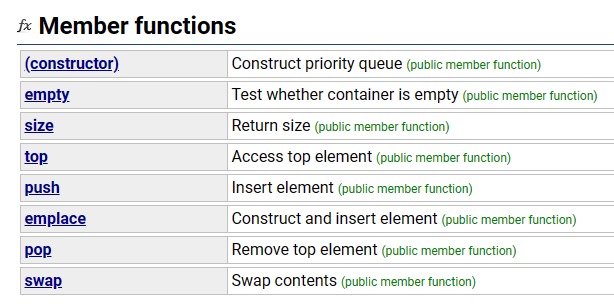


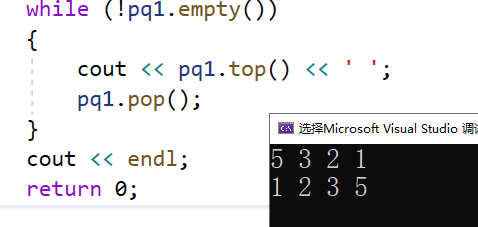


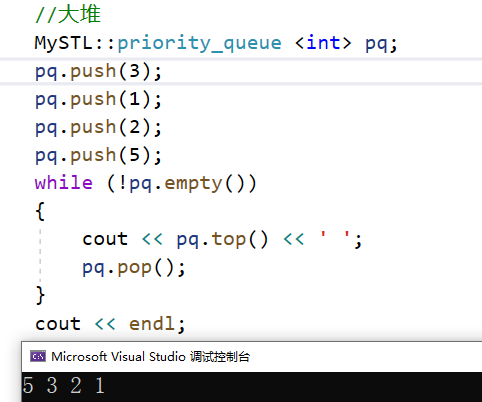
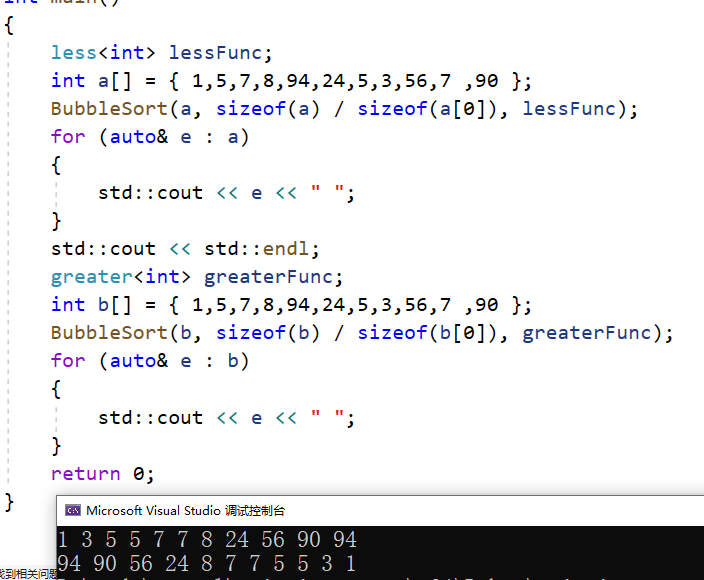

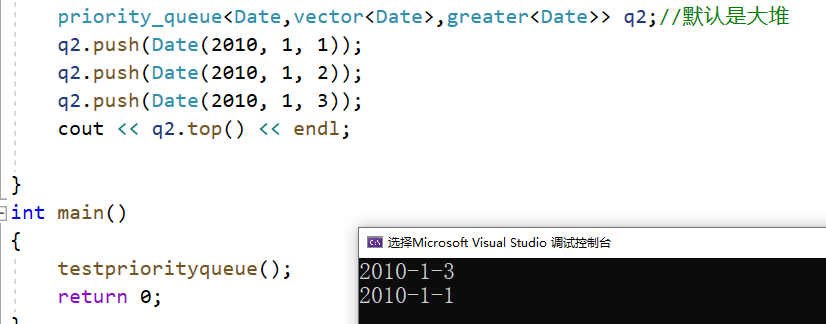
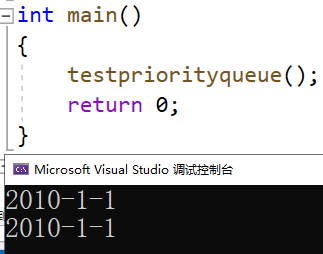
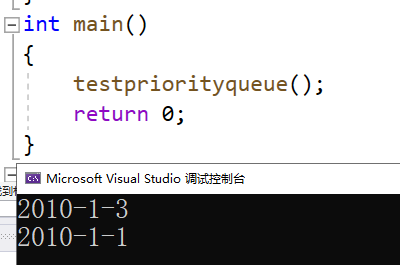
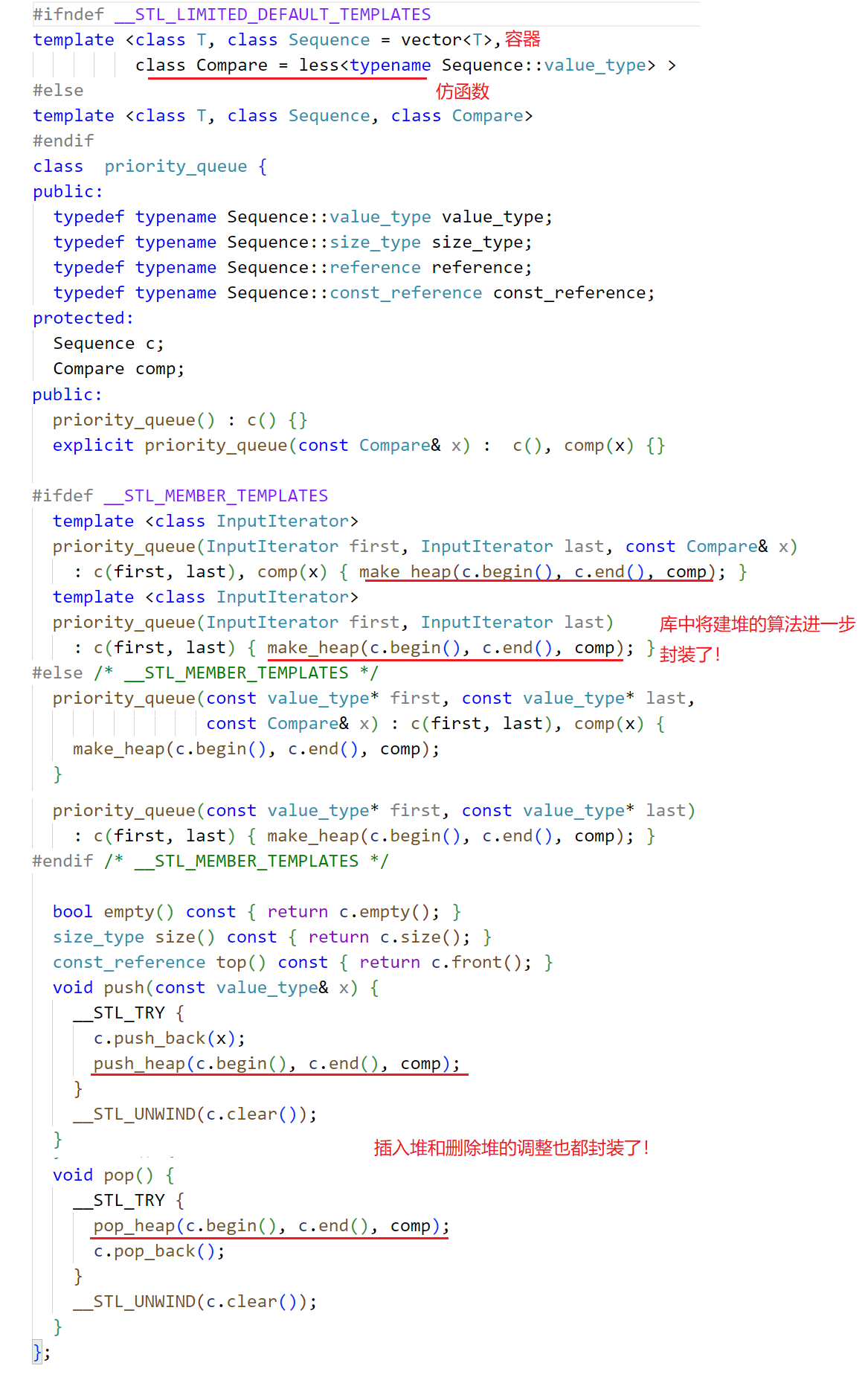















 459
459











 被折叠的 条评论
为什么被折叠?
被折叠的 条评论
为什么被折叠?










